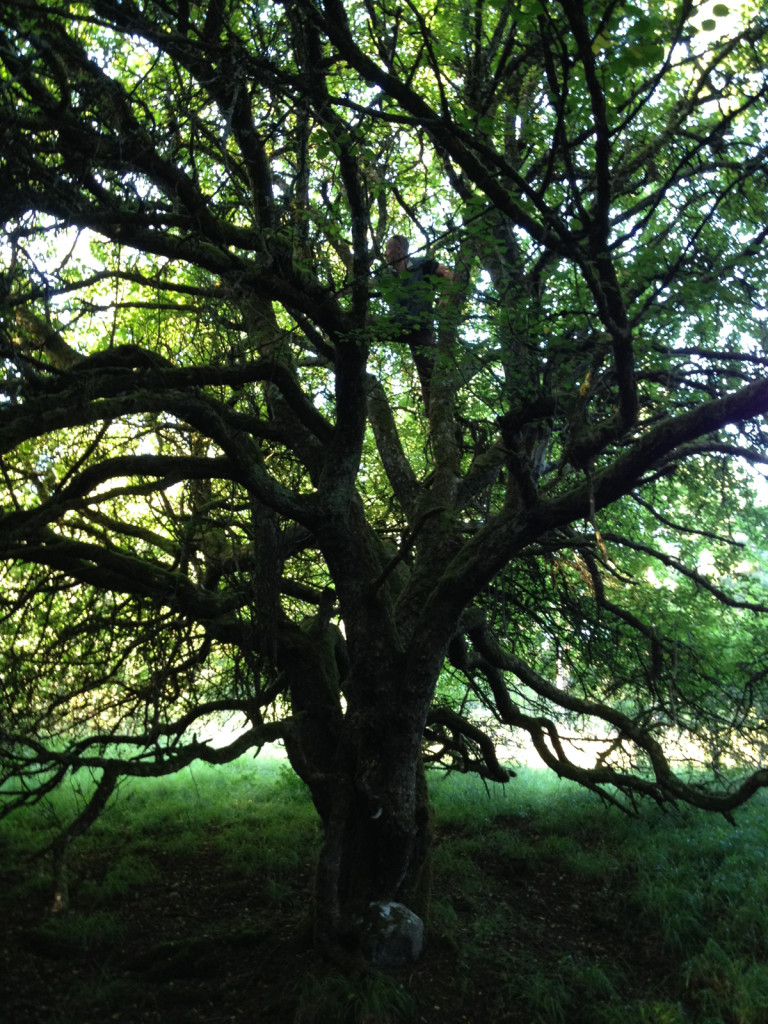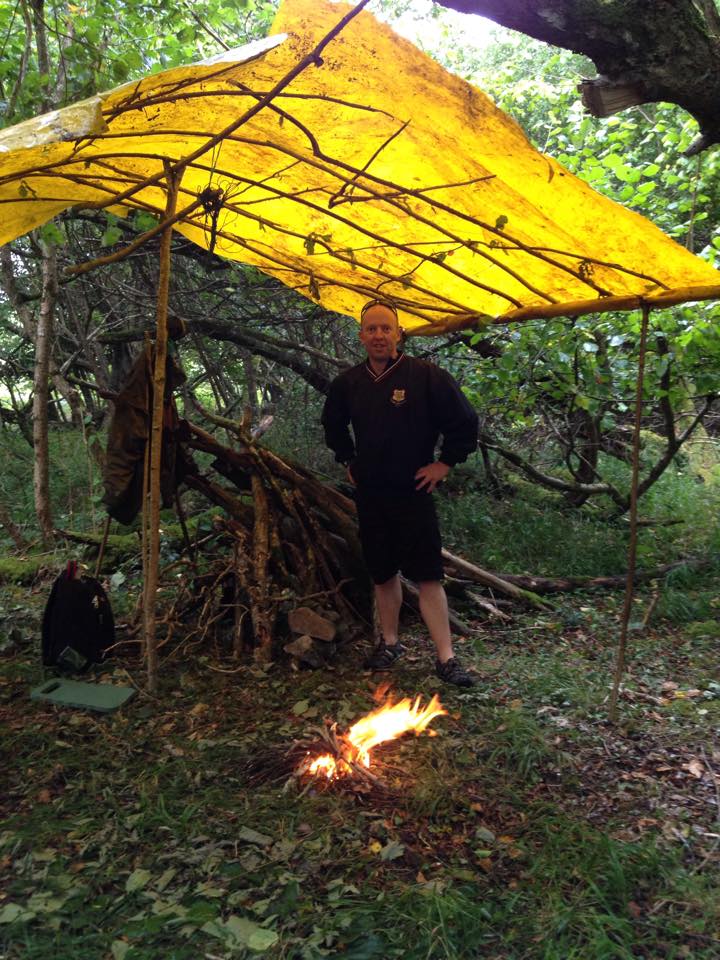By Sean Fagan

Can you see someone in photo above? Look at area that is slightly above centre of photo (Photo: Sean Fagan).
.
Is Tree Climbing a viable Bushcraft/Survival Skill?
.
Occasionally I climb trees to gain a better vantage point while navigating.
Trees are also great for wildlife observation, especially since it elevates human scent above wild animals.
In addition, trees can be surprisingly good for detecting animal trails and tracks.
However, tree climbing is dangerous and it's an activity I don't casually recommend unless done with safety & caution foremost in mind.
.
I’ve had the good fortune of receiving sound climbing advice and training from a tree surgeon, and a few times a year I go rock climbing – under the guidance of professional climbing instructors.
As regards the possible survival applications of tree climbing here is a few...
Climbing a tree could prove invaluable for gaining a more comprehensive and detailed view of the surrounding landscape - which can make all the difference in successfully navigating to salvation.
Tree climbing can also prove useful in avoiding dangerous, non-climbing animals.
Also, some trees yield fruit that can be difficult to dislodge from ground level.
The possible scenarios go on and on…
In summary - having a flexible mind-set, when out in wild places can prove invaluable.
.
So, is Tree Climbing a Viable Bushcraft/Survival Skill?
.
That answer depends entirely on an individual's interpretation of bushcraft (and survival skills).
You, and only you, can decide on that answer.
Of course, there is a valid argument that tree climbing is not a core bushcraft skill.
I get that.
But take, for example, canoeing - a skill set widely regarded by many as an important bushcraft skill to acquire - but it can, when seen in a certain light, have questionable applications.
Canoeing is a very enabling and enjoyable means of transport in such places as the Northern woods, where waterways abound - but it's an activity that carries some risk and is often unnecessary - it's a choice.
Canoeing is not a core bushcraft skill - unless you make it so.
What I'm getting at is this: outside of keeping yourself healthy and sane in wild places, it's imperative to make up your own mind about what's important - for you - as regards bushcraft.
Practise Thinking for Yourself...
.The outdoors, especially remote wilderness regions, are strewn with variables - and having a malleable mindset can be a crucial asset in dealing with the unpredictable.
Many outdoor enthusiasts are drawn to wilder, more remote regions of the planet where we can fully enjoy and flex our bushcraft skills.
There would seem to be an irresistible allure to these wild regions - places where nature stretches across every horizon.
But let's be real - nature rules these domains.
Not us.
We can never wake up one day in a wilderness and confidently proclaim to the wild yonder - "Nothing can harm me out here!".
Sure, we need a viable, core set of well-honed skills and knowledge to live well in these places.
And it's certainly not my intention to diminish the vital importance of knowing, practicing and honing the basics.
What I'm trying to emphasize is the crucial need of a flexible mindset for whatever nature might, and will, throw at us...
Especially when one of our cherished core skills is challenged in the wild - requiring some modification or alternative to work.
With this precautionary caveat in mind, I urge you to practice a little improvisation once in while.
To try things differently - because it's so easy to fall into familiar, rutted paths as regards our bushcraft skills and practise.
It's a fact of human nature that we sometimes seek out activities that bolster our confidence and sense of competence, often at the expense of what is most needed.
It's comforting to do bushcraft activities that we have a talent and liking for, but it doesn't stretch and expand our range of bushcraft skills and knowledge.
So, how do we know which skills we need to expand, which ones to consolidate, or which ones to even discard?
I can't really give you a tidy answer for that question.
This is all part of your personal bushcraft journey.
There are pitfalls - there is a risk of trying to learn too much, trying to grasp at too many skills - with the overall effect of diluting your efforts to the point of ineffectiveness.
As regards field-testing your skills - only in challenging outdoor conditions will you truly know if your skills are viable.
This is where you must think for yourself.
A bushcraft instructor/school can teach you a wealth of bushcraft skills and knowledge - but you, and you alone, must sieve through all the technical skills and information out there into a viable bushcraft package that works for you.
.

Improvisation is a key bushcraft skill and mindset. Tarp made with discarded plastic. The tarp proved its worth during a persistent downpour - dry enough to cook lunch (Photo: Sean Fagan).
.
Sleeping on a High...
.Years ago - there was a wood I liked to occasionally visit and do some bushcraft.
One day, I came across some massive sessile oaks.
They were magnificent.
The lowermost set of branches sprawled, pillar-thick, from the immensity of the main trunk. These massive branches were so thick and heavy they would've been sizable trees in their own right.
An ancient authority seemed to emanate from these huge oaks, with their deeply furrowed, Kraken-like limbs.
.
Over time I became very partial to one particular tree.
The first set of branches that sprung from this leviathan formed a somewhat flat, platform-like area about 20 foot above ground level.
One day, as I looked at this elevated, flat area - a thought spontaneously popped into my head - "That looks like a good place to sleep".
And that is what I did.
Lying on my bed up high, surrounded by massive branches - I slept reasonably well.
And waking up in an old oak to the first rays of light and a melodious chorus of birdsong was a special experience. .
.
That's the other thing...
Bushcraft should stir some part of being that loves to be outdoors.
.
Now you know the other reason why I still climb trees.
.
.
Related articles on this website:
- Outdoor Awareness Skills - The Importance of the Sit Spot
- Bushcraft and Art - Exploring Nature through Art
- The Joy of Camping in Winter
- Nature: A Bushcraft Perspective
.
Finally, a very inspiring short film about a man that loves climbing trees....
.
Pioneer Bushcraft Disclaimer
.
When I climb trees, I knowingly put myself at some risk.
If you climb trees you do so at your own risk.
I strongly encourage you (if outdoor climbing interests you ) to avail of appropriate and adequate training and practice.
In particular – become very familiar with safe rope work.
Always be aware of this essential fact: accidents can, and often happen in the outdoors - where medical assistance is limited or absent.
Always have that thought foremost in your mind - whenever pursuing an activity that could cause injury in the outdoors.

Recent Comments